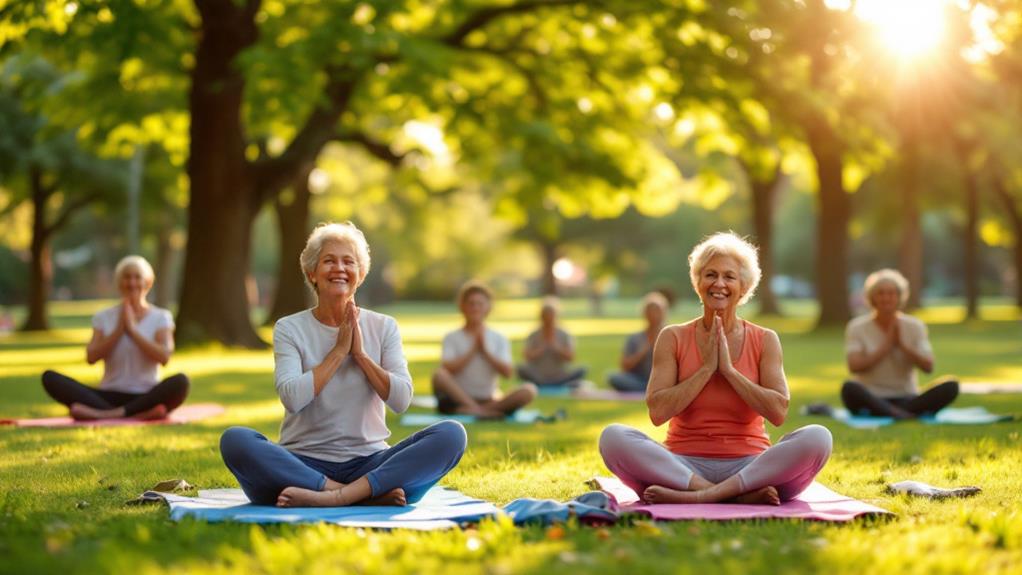Things to Consider Before Becoming a Yoga Teacher

Before becoming a yoga teacher, focus on understanding yoga deeply rather than just memorizing poses. Communicate clearly and adapt to meet different student needs. Create a non-competitive environment and accept various body types. Recognize your strengths, like empathy, and address personal challenges such as injuries. Balance your practice with self-care and mindful movement to prevent burnout. Consider the time and financial commitment of training programs, which could be online or in-person. Engage with supportive communities for growth and networking. As you investigate this path, you'll learn crucial factors to guarantee a fulfilling and impactful career in yoga teaching.
Knowledge Requirements
When considering becoming a yoga teacher, you'll find that knowledge requirements are more about understanding than perfection. A yoga teacher training course will guide you through the fundamentals of teaching yoga, focusing on an understanding of yoga rather than memorizing every detail. While many experienced yogis might use yoga poses in Sanskrit, prior knowledge of the language isn't vital. You'll gradually learn these names during your training, allowing you to focus on mastering your teaching skills.
In a diverse class, cueing in English often proves more inclusive and accessible for students. This approach guarantees everyone feels welcome, regardless of their familiarity with yoga terminology. Your grasp of physical practice and the nuances of each pose matter more than showcasing an advanced personal practice. Remember, leading a class and guiding others can be more challenging than performing the poses yourself.
The yoga teacher training course emphasizes cultivating an understanding of yoga, prioritizing your ability to communicate effectively and adapt to students' needs. As you develop your teaching skills, you'll learn that being an effective teacher is less about doing every pose perfectly and more about your ability to inspire and guide others on their yoga path.
Physical and Flexibility Needs
Adopting the path to become a yoga teacher involves recognizing that physical prowess and extreme flexibility aren't the primary requirements. While you might think mastering advanced asanas like handstands is vital, effective teaching often arises from practicing alongside your students and guiding them through each pose. High flexibility isn't necessary; instead, focus on understanding the step-by-step breakdown of poses, which is significant for a successful teaching practice. As a teacher, you should feel confident demonstrating poses with whatever flexibility you possess, as teaching yoga is about sharing your unique strengths rather than showcasing personal performance.
Here are some key points to reflect upon:
- Props are your allies: Encourage students to use blocks, straps, and other tools to assist in challenging poses.
- Non-competitive atmosphere: Yoga teacher training should foster personal growth, allowing you to develop your teaching style at your own pace.
- Diverse body types: Accept the idea that all body types can effectively teach and demonstrate yoga.
- Focus on practice: Consistent asana practice helps you connect with your students' experience.
- Engage with students: Practice alongside them to better understand their needs and progress.
Personal Strengths and Challenges
Recognizing your personal strengths and challenges is an important step in becoming an effective yoga teacher. Accept your path by acknowledging what you bring to the table, regardless of whether it's empathy, communication skills, or a deep understanding of yoga philosophy. These strengths improve your teaching effectiveness and help create a supportive learning environment for your students. As you focus on personal development, keep in mind that yoga teacher training encourages self-discovery over competition, allowing you to build confidence and refine your unique teaching style.
Understanding anatomy and alignment is another vital aspect, as it increases your confidence in guiding students safely through poses. Your personal experiences, like postpartum body changes or previous injuries, aren't setbacks; they're assets that offer you a unique perspective in teaching and connect you with students facing similar challenges. This personal touch can set you apart and enrich your teaching approach.
Emotional and Well-Being Considerations
Diving into yoga teacher training can be an emotional rollercoaster, as you're likely to encounter a spectrum of feelings ranging from exhaustion to profound self-discovery. It's common to experience emotional release, such as crying, as you confront personal baggage and growth challenges. This self-reflection is fundamental for personal development, although it can feel overwhelming at times. Allowing these emotions to flow freely is vital for your healing and growth.
Balancing your physical practice with mindful movement is important to prevent injuries and maintain your comprehensive well-being. Remember, this process is as much about nurturing your mind and spirit as it is about mastering poses. Self-care practices play a significant role in managing both your emotional and physical well-being during this transformative experience.
Consider these strategies to support your progress:
- Embrace emotional release: Don't hold back; let your emotions surface and guide your growth.
- Prioritize self-reflection: Use journaling or meditation as tools to deepen your introspection.
- Develop a self-care routine: Incorporate activities that replenish your energy.
- Balance your physical practice: Listen to your body and avoid overexertion.
- Seek support: Connect with fellow trainees or mentors for encouragement and shared experiences.
Educational Structure and Costs

When considering yoga teacher training, you'll find that these programs typically offer an extensive curriculum covering diverse aspects such as asanas, pranayama, meditation, philosophy, anatomy, and teaching methods. The educational structure varies, with programs ranging from a few weeks to several months, allowing you to choose the duration that fits your schedule. Tuition fees are a significant factor, often amounting to thousands of dollars. These costs can include not only the program itself but also supplementary expenses like materials, books, and travel.
Fortunately, many teacher training programs provide flexible options. Regardless of whether you prefer in-person, online, or hybrid formats, there's likely a setup that aligns with your lifestyle and commitments. If you're facing financial constraints, some programs offer scholarships or payment plans, making this educational investment more accessible.
Assessing your commitment to personal practice is essential before enrolling. Most programs expect you to maintain a daily routine outside of scheduled classes, emphasizing the need for time management and dedication. Balancing this commitment with financial and educational considerations will help you choose the right program. With thoughtful planning, you can set out on a rewarding expedition to become a yoga teacher.
Community and Networking Opportunities
A yoga teacher training program's community can be a crucial element in your path to becoming a certified instructor. As you commence this yoga expedition, you'll find yourself surrounded by a supportive community of fellow students, all working towards a common goal. This environment fosters collaboration and shared experiences, enhancing your learning process and creating a sense of belonging.
In addition to the immediate support, these programs offer valuable networking opportunities that extend beyond the training itself. Connecting with fellow trainees can lead to lifelong friendships and professional connections in the yoga industry. Many programs also provide access to alumni networks, ensuring ongoing mentorship and guidance even after you become certified.
Consider the following benefits of engaging with your yoga community:
- Shared learning experiences that deepen your understanding and practice.
- Professional connections that can lead to job opportunities and collaborations.
- Access to alumni networks for continued support and growth.
- Opportunities to attend workshops, retreats, and yoga festivals for career advancement.
- A sense of belonging within a like-minded community dedicated to wellness.




